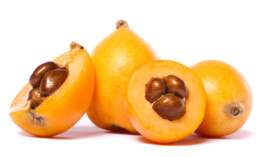Loquat: a fruit loved by many and unknown to others
One of the first stone fruits in spring, the loquat, belonging to the Rosaceae family, a juicy and refreshing fruit, which began to be cultivated in Spain last century, capturing the attention of many, thanks to its sweet flavor combined with tones acids.
Originally from Asia, this delicious little oval and orange fruit is loaded with essential nutrients and has a rich history dating back thousands of years.
Origin and History of the loquat
Historical records indicate that 3000 years ago nispers were cultivated in the Caspian Sea region. Through trade routes, loquat expanded to different regions of the world, including the Mediterranean basin and Latin America, adapting perfectly to subtropical and temperate climates.
Loquats have been cultivated and appreciated for their medicinal properties and sweet flavor for more than 2,000 years.
His arrival in Europe
Greece was one of the first countries for which there is data on the cultivation of loquat, introduced in the year 700 BC. spreading throughout Europe, becoming a very important crop of the Roman Empire and during the Middle Ages.
The loquat was introduced to Spain by the Callosian botanist Juan Bautista-Berenguer in the 18th century, being a success due to its rapid adaptation to the Mediterranean soil and climate.
Varieties in Spain
Although it is an ancient fruit, which has enchanted many people, today the benefits of this fruit are still not fully taken advantage of, some due to lack of knowledge, others because being a delicate fruit, it can quickly develop stains on its delicate skin. , reduces its attractiveness, in addition to being short-season. To reduce this problem, farmers carry out delicate handling of the fruit, in many cases manually.
Today the most commercialized varieties are classified into two groups; the Japanese and Chinese loquat. The first is characterized by having a more opaque color of both the pulp and the skin, fewer seeds and earlier maturation, while the second is known for a more intense color of the skin and pulp, contains more seeds, is characterized by a ripening later and is very aromatic.
From these two groups are derived the Algerie or Algerino, Tanaka, Golden Nuget, Peluche.
Among all these varieties, the loquat from Alicante area stands out, which in 1992 obtained the distinction of Protected Designation of Origin Nísperos de Callosa d'en Sarrià. A product with a quality seal, thanks to the demanding handling processes, control of caliber, defects and flavor, which have given it recognition throughout Europe.
According to the varieties of níspero, the season covers from April to May, some until June, it is recommended to eat it ripe because otherwise it could be indigestible.
Nutritional Properties of Níspero
The loquat is a rich source of vitamins and minerals, standing out in its composition:
- Vitamin A: Fundamental for visual health and immune function.
- Vitamin C: Powerful antioxidant that protects against cellular damage and strengthens the immune system.
- Dietary fiber: Promotes healthy digestion and helps maintain adequate blood sugar levels.
- Potassium: Essential for muscle function and regulation of blood pressure.
Además de estos nutrientes, el níspero contiene una variedad de antioxidantes como los carotenoides y los polifenoles, que ayudan a combatir los radicales libres y a reducir el riesgo de enfermedades cardiovasculares, reducir el colesterol y niveles de azúcar en la sangre.
Being rich in carotenoids, it contributes to skin care, preparing it for summer and thus being able to obtain a good tan, which is why it is also known as “beauty fruit.”
The loquat, with a rich ancient history, comes to our days as a great ally in the diet, it can help improve general well-being, providing essential vitamins, antioxidants and a flavor that you will love. Whether you enjoy it fresh or in one of its various derived products, the loquat is an excellent option for a healthy diet.

